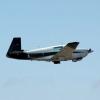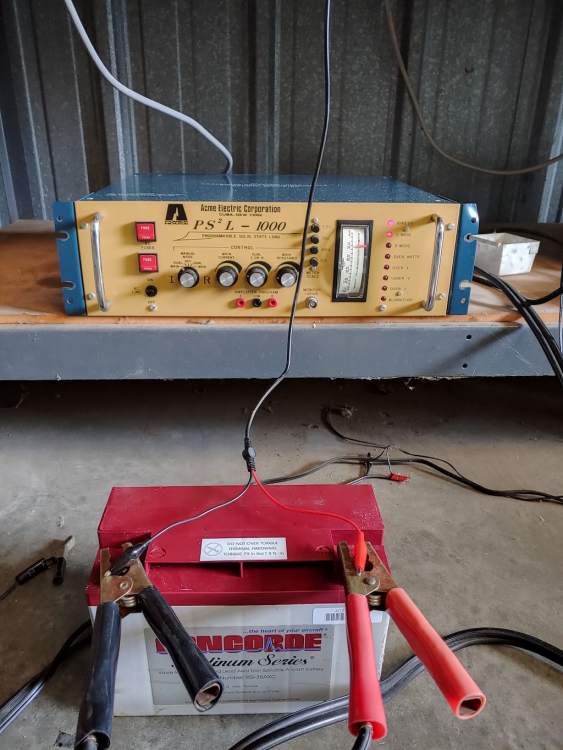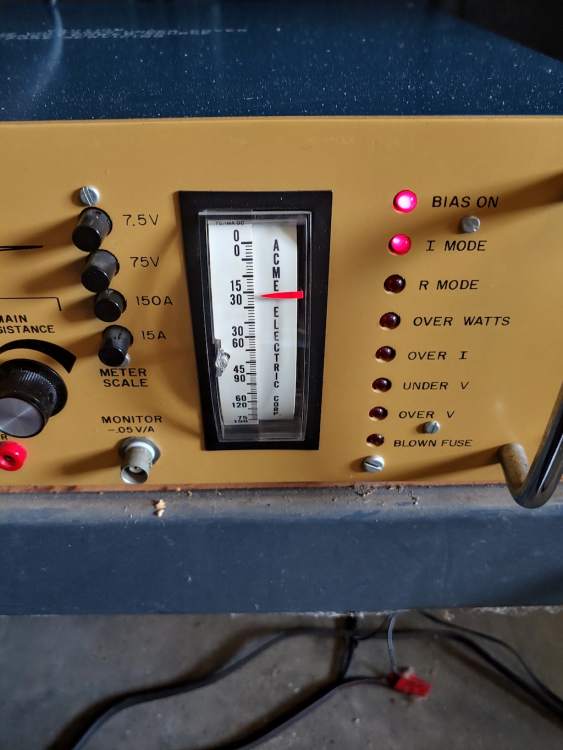-
Posts
867 -
Joined
-
Last visited
-
Days Won
1
Content Type
Profiles
Forums
Blogs
Gallery
Downloads
Media Demo
Events
Posts posted by wishboneash
-
-
Hi
I am interested in your Flightstream 210 and the Airspeed indicator if you still have them available.
Thanks.
-
Sent you a direct message. Thanks!You got it, Sriram. Please send me a shipping address. I'd bring it over but I'm going to be gone for a bit. I'll try to ship it later today.
-
Hi
I'll take it if it's still available. I am at KLVK.
N201LW
Sriram -
I would recommend Executive Autopilots in Sacramento (KSAC). They fixed my Century IIB about 8 years ago. Good luck.
-
Apparently JPI had replaced the fuel board and the motherboard (besides the display) and brought it up to current standards/versions. That explains loss of all calibration data and hence the fuel level related errors. I "recalibrated" both tanks (mock re-calibration using old data) and the errors are gone. I had to update total fuel (main/aux) since those were default values and also updated the CHT warning limits which had been lost. I will do a full re-calibration as per the service manual and that will be the end of it.
-
 2
2
-
-
On 6/18/2023 at 8:56 AM, Fly Boomer said:
Let us know if you get satisfaction from JPI.
I got the unit back a few days ago. The repair charge was 1/2 an AMU for the display replacement.
Unfortunately, I get a fuel sensor error on the right main on plugging back in (ERROR R-MAIN). I had NO issues with the fuel level sensors (which are analog, not CiES) earlier. I checked the resistance on both tanks and I am getting very odd results. This is on the P5 connector. The ground line (black) which are shorted together from both sensors is 1.1k ohms to chassis ground and the resistance from signal (white-L, green-R) to ground is over 56k ohms for both tanks! Hopefully I am doing this right. Isn't it in the 0-300 ohm range? Fuel level is about the same on both tanks and fairly low (didn't dip stick measure). I can't do much until after the holidays so troubleshooting suggestions are welcome.
-
 1
1
-
-
25 minutes ago, Fly Boomer said:
Exposed to any "shocks" like extreme temperature, over-voltage, water, other? I don't have one, but I would have expected them to be nearly bulletproof.
No, I don't believe so, it isn't too hot yet here and battery/charging system all fine. It won't go past the splash screen, so I am guessing some hardware/software issue that perhaps failed some initial checks.
-
After 8 years or so of ownership, my EDM 900 has failed. Not the display itself, but it doesn't "boot up" after powering on. The JPI logo shows up for a few seconds then the whole thing shuts down. I guess the plane is grounded. Will have to send the unit back to JPI I guess and see how much they charge to get it fixed.
-
I'd probably let go of the Shadin if I were you. You will not have the LOP/ROP functionality without fuel flow in the EDM 900. The logging features are always nice to have such as to keep track of trends as you can download and study them later (also check GAMI spreads using the EDM software).
-
 1
1
-
-
I have a temperature controlled fan/heater which sends in warm air from below the cowl flaps. The engine is at a fairly constant temperature of 18-20C. The probe is placed inside the air intake on the top of the engine. I also place a blanket on top of the engine to provide some insulation. The heater only comes on when necessary so there's no unnecessary heating on warm days.
-
I have had the Icom A22 for over 25 years. I think I have rebuilt the battery three times. Still going strong.
-
 1
1
-
-
Wow, I can see some confusion with this "extended downwind" terminology. Perhaps, in this situation, landing Rwy 27 left pattern, saying you are 2 miles west of the field entering downwind will clarify the situation as opposed to being 2 miles on an extended downwind to the east. Better yet, at a busy airport it's best to avoid the downwind entry and do the standard 45 entry. At Watsonwille (KWVI), this has happened to me many times and I always fly the 45 entry into this uncontrolled field as it can be extremely busy on a Saturday morning after the fog lifts. Coming from the north to land Rwy 20 (left pattern) can result in some interesting manoeuvres especially with terrain to the north.
-
 2
2
-
-
20 hours ago, Rikk said:
I tried 121.6, but got no noise at any point of turning the D3 on and off. Of course, my noise on the Strikefinder goes away a lot, but still pops up sometimes, after I’ve shut off the D3, removed it, and pulled the breaker. I’m so confused!!
Thanks for running the experiment. Both my handheld and the panel radios pick up the noise on 121.6MHz, not all the time but most of the times. It happened with the D2 unit as well which I returned a couple of times and finally "upgraded" to the D3 which has the same issue. I give up

-
16 hours ago, Rikk said:
I have a D3 and I think I have narrowed it down to it being the source of strange strike patterns that appear on my Insight Strikefinder about half the flight. It might be that it happens when the charging indicator is yellow battery bar (not charging) with a red exclamation point (overheated, can’t charge). I don’t seem to have the problem when it is a green battery bar and lightning bolt. Didn’t have the problem with the Dynon D2.
Hi, would you mind tuning your panel COM radio to 121.60 and see if you pick up any interference from the D3? It usually happens around the time the splash/disclaimer screen shows up. I had forgotten about this thread, but I did repeat the test with an RF spectrum analyzer (SA) and saw a signal show up at 121.6MHz. It wasn't very strong signal but it was enough for my GTN650 to pick it up. I had taken a video of the SA screen as I turned on the D3 but unfortunately I can't seem to find it now. Will try to repeat it sometime. There were a bunch of other frequencies that popped up on the SA, but none that I have run into while I have been flying. 121.6 is ground at Livermore and it is definitely annoying when it happens. To avoid this, I turn on the D3 after I am in the run up area. Dynon hasn't been of much help in resolving this.
-
A nice 252. Probably the most efficient Mooney out there.
-
 1
1
-
-
Interesting all in one product as a cheap backup attitude/AOA indicator (not sure how well these work though). I currently have the wing mounted CYA 100 and a Dynon D3.
https://uavionix.com/products/av-20s/ -
1 hour ago, PT20J said:
Yes.
45 years ago, Lycoming changed the standard timing on IO-360s from 25 degrees to 20 degrees. Reasons given were lower CHTs and increased detonation margin in extremely cold temperatures. The change requires a magneto with a 15 degree lag angle for starting and the dual magnetos were not available in that configuration so the dual mag engines were not included. If you have a A3B6, you can change it back to 25 degrees by installing the correct left magneto, retiming and marking the data plate with only a logbook entry since both timings are in the TCDS.
Skip
SI1325 Timing Change for IO-360 Series Engines.pdf 470.94 kB · 3 downloads
Thanks for the info!
-
30 minutes ago, jaylw314 said:
IIRC the A3B6D only has 25 deg BTDC, the A3B6 can be either 25 or 20 deg. I'm not sure, but I think it comes standard as 20 deg, and you have to change the nameplate if you change to 25 deg
That's what I recall. 20 deg keeps the CHTs lower I presume.
-
Isn't the standard timing on the A3B6D 25 deg BTDC compared to 20 deg for the A3B6 variant?
-
-
I recently got this beautiful beast of a load tester which I used on my aging Concorde RG35-AXC battery and as expected it was right on the brink of passing at a little over 80%. I may re-test again after another full charge in a few months when it is colder and give it a full charge of around 14.2V. This test was done after taking it off the battery minder at 20C and open circuit voltage was 13.46V. Measurements were taken every 5 minutes. Next time, I will automate the measurements and take more frequent readings since the voltage starts to plummet once it reaches around 11V.
-
1 minute ago, MooneyMitch said:
Hobbit............you may be ok as you're NOT an older pilot yet............are you?

Almost 60... getting close to that zone where they start to scrutinize you!
-
16 minutes ago, MooneyMitch said:
The following is strictly my opinion ;
Regarding information from the folks in the video.................I found it very interesting and very revealing.............basically, there is NO industry data to support the rate increases...............and per Marci at Avemco [and as and underwriter, she does have the data], there is no data to support saying that older pilots claims are increasing.
And all this [my opinion again only]............we've had it really good for a long time!
I am waiting to see what happens this coming year, due early Feb 2021. I have pinged my broker for a heads up.. The biggest increase for me was 2 years ago. Last year it didn't change much.
-








M20K Rocket Avionics For Sale
in Avionics / Parts Classifieds
Posted
Will do. Thanks...
Sent from my Pixel 8 Pro using Tapatalk